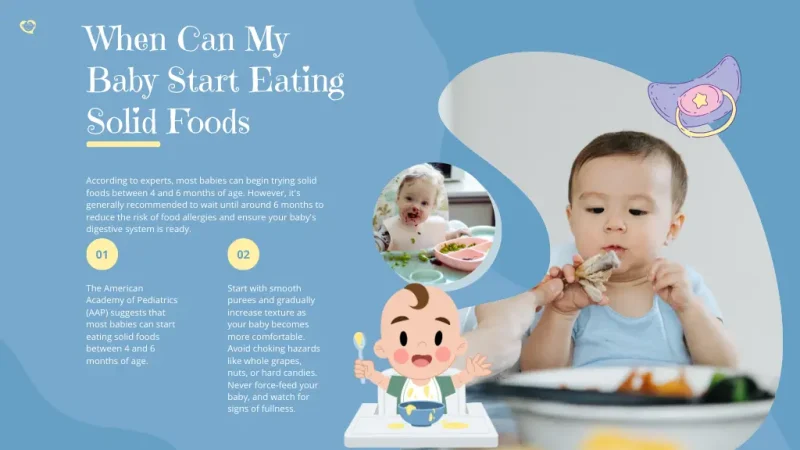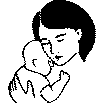New parent’s minds as their little one grows and develops. It’s an exciting milestone that marks a new chapter in your baby’s life, filled with new tastes, textures, and experiences.
According to experts, most babies can begin trying solid foods between 4 and 6 months of age. However, it’s generally recommended to wait until around 6 months to reduce the risk of food allergies and ensure your baby’s digestive system is ready.
In this article, we’ll explore the signs of readiness, first food options, and best practices for introducing solids to your baby.
We’ll also address common concerns and provide tips to make this transition smooth and enjoyable for both you and your little one.

Signs Your Baby is Ready for Solid Foods
While age is a general guideline, it’s important to look for specific developmental signs that show your baby is ready to start solid foods.
Here are the key indicators to watch for:
- Good head and neck control: Your baby should be able to hold their head steady and upright without support. This is crucial for safe swallowing.
- Sitting up with minimal support: Your little one should be able to sit in a high chair with good stability. This posture helps prevent choking.
- Loss of tongue-thrust reflex: Babies are born with a reflex that pushes food out of their mouths. When this reflex diminishes, they’re better able to move food to the back of their mouth for swallowing.
- Increased appetite: If your baby seems hungry even after a full day’s worth of milk feeds, it might be time for solids.
- Showing interest in food: Watch for signs that your baby is curious about what you’re eating. They might reach for your food or open their mouth when you’re eating nearby.
- Ability to make chewing motions: Even without teeth, your baby should be able to move their jaw up and down in a chewing motion.
- Can transfer objects to their mouth: This shows hand-eye coordination and the ability to self-feed, which are important skills for eating solids.
- Doubled birth weight: Many babies are ready for solids when they’ve doubled their birth weight and weigh about 13 pounds or more.
Remember, every baby develops at their own pace. Some might show these signs earlier, while others may take a bit longer. If you’re unsure, it’s always best to consult with your pediatrician before starting solid foods.
Pro tip: Look for a combination of these signs, rather than just one or two, to ensure your baby is truly ready for this big step in their nutritional journey.
Recommended Age to Start Solids:
When it comes to introducing solid foods to your baby, timing is crucial. While every baby develops at their own pace, there are general guidelines that most pediatricians and health organizations recommend:
The American Academy of Pediatrics (AAP) suggests that most babies can start eating solid foods between 4 and 6 months of age.
However, many experts, including the World Health Organization (WHO), recommend waiting until around 6 months before introducing solids.
Why the emphasis on 6 months?
Here are a few key reasons:
- Digestive system maturity: By 6 months, a baby’s digestive system has typically developed enough to handle solid foods.
- Reduced allergy risk: Waiting until 6 months may help lower the risk of developing food allergies.
- Nutritional needs: Up until 6 months, breast milk or formula usually provides all the nutrients a baby needs.
- Physical readiness: Most babies have developed the necessary motor skills and loss of tongue-thrust reflex by 6 months.
It’s important to note that every baby is unique. Some may be ready slightly earlier, while others might need a bit more time.
Always consult with your pediatrician before starting solids, especially if you’re considering starting before 6 months.
Remember, there’s no rush to start solids. Breast milk or formula will continue to be your baby’s primary source of nutrition throughout the first year.
Introducing solids is more about helping your baby learn new skills and tastes rather than providing essential nutrition at this stage.
What baby food should I introduce first?
When starting your baby on solid foods, it’s important to choose the right foods first. Many pediatricians recommend starting iron-fortified baby single-grain cereals mixed with breast milk or formula. This combination is easy to digest and provides essential nutrients. Visit for more details:
Introducing New Foods:
Introducing New Foods to your baby is an exciting journey of discovery. Start with single-ingredient purees, introducing one new food every 3-5 days.
This approach helps you identify any potential allergies or sensitivities. Begin with iron-rich foods like fortified cereals or pureed meats, then move on to vegetables and fruits.
Offer a variety of flavors and textures to develop your baby’s palate. Remember, it’s normal for babies to reject new foods at first – patience and persistence are key.
Keep mealtimes positive and relaxed, allowing your baby to explore foods at their own pace. As your little one grows, gradually increase food consistency and introduce soft finger foods to promote self-feeding skills.
Some Foods to Avoid for a Baby
While introducing solid foods is exciting, it’s crucial to know which foods to steer clear of during your baby’s first year.
Here’s a list of foods to avoid:
- Honey: Can contain botulism spores, dangerous for babies under one year
- Cow’s milk: As a drink (not in cooking) before 12 months
- Choking hazards: Such as whole grapes, nuts, popcorn, and hard candies
- Raw or undercooked eggs: Due to salmonella risk
- Unpasteurized foods: Including some cheeses and juices
- Added salt or sugar: Babies don’t need these in their diet
- Certain fish: High in mercury, like shark, swordfish, and king mackerel
- Sticky foods: Like peanut butter (unless thinned out)
- Fruit juices: The AAP recommends avoiding juice for babies under 12 months
Remember, always consult with your pediatrician about specific dietary concerns for your baby. It’s better to be safe than sorry when it comes to your little one’s health and safety!
Feeding Schedule and Portions
As you embark on the journey of introducing solid foods to your baby, you might wonder about the right feeding schedule and portion sizes.
Every baby is unique, and these guidelines are just that – guidelines. Always follow your baby’s cues and consult with your pediatrician for personalized advice.
Start small: In the beginning, solid foods are more about introducing new tastes and textures than providing nutrition. Your baby’s primary source of nutrition will still be breast milk or formula for the first year.
Gradual increase: As your baby grows and becomes more comfortable with solids, you’ll gradually increase the amount and variety of foods. Here’s a general guide to help you navigate this transition:
| Age | Meals per Day | Portion Size per Meal | Types of Food | Feeding Tips |
| 4-6 months | 1-2 meals | 1-2 tablespoons | Single-grain cereals, pureed fruits and vegetables | – Start with one meal a day – Offer solids after breast/bottle feeding – Introduce one new food every 3-5 days |
| 6-8 months | 2-3 meals | 2-4 tablespoons | Single-grain cereals, pureed/mashed fruits and vegetables, pureed meat | – Gradually increase to 3 meals a day – Introduce soft finger foods – Offer water in a sippy cup |
| 8-10 months | Three meals + 1-2 snacks | 4-6 tablespoons | Mashed or chopped fruits and vegetables, ground meats, beans, yogurt, cheese | – Encourage self-feeding with finger foods – Offer a variety of textures – Introduce a spoon for self-feeding attempts |
| 10-12 months | 3 meals + 2 snacks | 6-8 tablespoons | Chopped family foods, soft meats, fruits, vegetables, grains | – Transition to table foods – Encourage drinking from a cup – Offer a wide variety of foods |
Important notes:
- Follow your baby’s lead: Some days, your baby might eat more, other days less. This is normal!
- Watch for fullness cues: Your baby might turn away, close their mouth, or push food away when full.
- Breastfeeding/formula feeding: Continue on-demand feeding alongside solids introduction.
- Avoid pressure: Never force your baby to finish a portion. Trust their ability to self-regulate.
Remember, introducing solids is a gradual process. It’s not just about nutrition but also about developing motor skills, exploring new tastes and textures, and fostering a positive relationship with food. Be patient, stay consistent, and enjoy this exciting new phase of your baby’s development!
Safe Feeding Practices:
When introducing solid foods to your baby, safety should be your top priority. Always supervise your baby during meals and ensure they’re sitting upright in a high chair or feeding seat.
Start with smooth purees and gradually increase texture as your baby becomes more comfortable. Avoid choking hazards like whole grapes, nuts, or hard candies. Never force-feed your baby, and watch for signs of fullness.
Introduce new foods one at a time, waiting 3-5 days between each new food to monitor for any allergic reactions.
Remember to continue breastfeeding or formula feeding alongside solids, as milk remains a crucial part of your baby’s nutrition during the first year.
Conclusion
Introducing solid foods to your baby is an exciting milestone, typically occurring around 6 months of age. Every child develops at their own pace, so watch for signs of readiness rather than focusing solely on age.
Start slowly with single-ingredient purees, gradually introducing new foods and textures. Always consult your pediatrician before making significant changes to your baby’s diet.
The journey to solid foods is a fun adventure for both you and your little one, filled with new experiences and occasionally messy moments.
Embrace this phase with patience and enthusiasm, knowing you’re helping your baby develop healthy eating habits that will last a lifetime.

Pingback: Why is there metal shards in baby food? The Surprising Truth About Heavy Metals in Infant Nutrition
Pingback: Can A 1 Year Old Have Crisps? Exploring the Safety
Pingback: Baby Food Ideas For 9 Months: A Complete Guide for New Parents - Baby Care Corner
Pingback: When Do Babies Stop Eating Baby Food? A Detailed Breakdown By Age And Development - Baby Care Corner
Pingback: Step-by-Step Guide to Making Vanilla Custard Baby Food at Home - Baby Care Corner